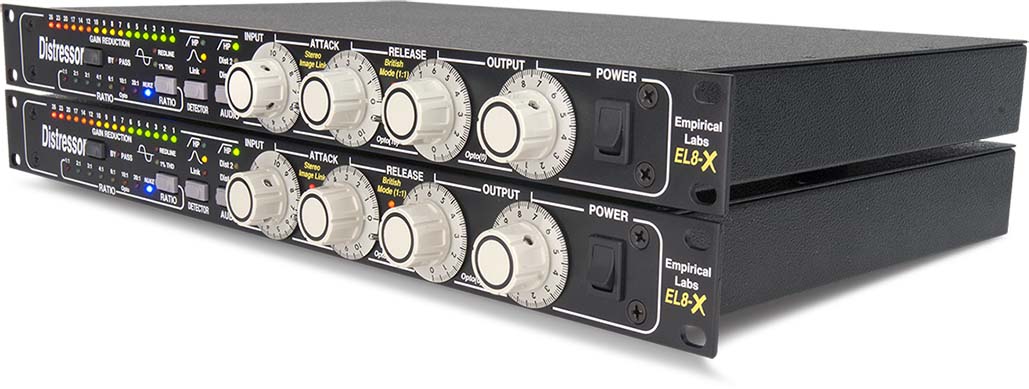The original concept of the “British Mode” came from an unusual setting on the classic UREI LN1176 limiter. The unit was designed to have only four ratios, each ratio being engaged by selecting one of four buttons. However, as early as 1980 (or before), renegade recording engineers, always on the lookout for something a little more “over the top”, found that you could make all four buttons stay “in” if you pressed them just right. What resulted was a very, very aggressive sound that had some elements of the units 20:1 ratio, but with an unusual knee and new envelope shape. Somewhere along the line, someone called it a “British Mode” and the name has stuck. It is also called “all buttons in” and some other intuitive names.
The Distressor has the advantage of being able to apply this “aggressive” nature not only to the new British ratio (1:1) but also to all the ratios since a separate switch is installed, which can be enabled with any ratio. One should keep in mind however, that an attack below 3 or 4 is required to maintain the LN1176 character. If you go above an attack of 3 you will also incur a rise in some grunge (distortion) and see the THD indicator lites come on a lot more. The Distressor will no longer behave smoothly, nor like an 1176.
How to use the new British Mode Option for the first time
Put the unit in the 1:1 ratio and turn on the British Mode Switch (flip it up and the LED should be lit). That enables it. To sound like the 1176 the only constraint is to keep the attack well under 4 on the Distressors – their attack can go much longer than the 1176. Now you will find that the unit has a new attitude! The attack and release will generally be more aggressive and the unit will get in and out of the way very quickly. Interestingly, the unit will be slightly less colored when not compressing.
Tips
Use this ratio to “skim” peaks. This means that most of the time it may not be doing anything, but when it does “hit” the signal, it will smoothly push back the signal and then get right out of the way again. If you are hitting the Gain Reduction all the time with the British mode on, you are going to be really “squashing” the signal. On the other hand, the Distressor will sound fairly subtle when compressing all the time in 2:1 mode, especially with a slower attack (>6).
Tricks
Vocals! – This is a great final compression during mixdown. When not working it is very transparent, but when a vocal pops out and hits the compression, the British mode will get in and out of there quickly and smoothly. When you are really compressing a lot, breaths and background noises will become very loud (pushed up). There is not much you can do with this except gate before compression maybe or, mute or erase the noises and breaths out that you don’t want to hear. Remember that breaths are natural and can add a lot of excitement sometimes, so don’t gate or erase them by default. If you can, back up a vocal track before you start trying to punch out breaths and noises etc.
WHAT PEOPLE SAY ABOUT THE BRITISH MODE MODIFICATION
For those who have come to love and depend on the sound of the Distressor, the new British mode turns it into a new fun loving animal.
At the flick of a switch, the Distressor becomes more aggressive and stressful on any instrument you desire.
Dave Derr should win the “t**s” award for coming up with such a nice but nasty box. – Michael Brauer
A short while ago, I spoke to Judy there about the Stereo Image Link & the British Mods. Both are major enhancements to the Distressor, the British sound being a kind of hard drug! You hear it once, & then you can’t imagine using a Distressor without it… J
